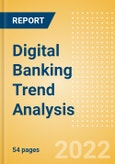While the COVID-19 pandemic has proved that digital banking is essential for consumers and business' access to finance, the past year has shown that digital challengers are not taking their customers for granted and behaving under the assumption that their growth and sustainability is guaranteed. Most of the banks discussed in this report have taken significant steps to strengthen and/or adapt their strategies over the past two years. While some banks have doubled down on their emphasis on customer acquisition and expanding their offering, others have taken a more targeted approach aimed at diversifying their revenue streams. Moreover, achieving profitability in the near future has increasingly become the top priority of many of those managing digital challengers, most of which remain loss-making. Ultimately, the path towards profitability will not only depend on digital challengers' strategies and product development but also on consumer attitudes, the regulatory environment specific to each country/region, and the overall competitiveness of the markets within which they operate.
Scope
- Digital challengers are increasingly providing loans and becoming less reliant on transaction fees. Starling Bank in the UK and bunq in the Netherlands are two examples of digital challengers that have introduced loan products over the past two years. In doing so, they have joined other banks such as KakaoBank in South Korea and ubank in Australia in adopting a more traditional balance sheet approach based on net interest income.
- Whereas a balance sheet approach is associated with profitability, a strategy based on aggressive customer acquisition is not. The two banks that have managed to generate profit - Starling Bank and KakaoBank - have largely managed to do so because of their lending activities. Other actors that have expanded aggressively in terms of market share (such as Revolut) are still struggling to make profit.
Reasons to Buy
- Gain insight into the strategies, product bundles, and messaging digital banks are trying in each market, with their associated strengths and weaknesses.
- Learn about threats to incumbents and newer digital challengers, as well as potential opportunities for acquisitions and partnerships.
- Understand the relative viability of different digital banking models across different contexts.
- Gain an awareness of the general trends affecting the digital banking space.
- Compare the performance and strategic direction of your firm against competitors.
Table of Contents
1. Executive Summary1.1 Overview
1.2 Key findings
1.3 Critical success factors
1.4 Competitor overview
2. The Global Digital Challenger Bank Market
3. The UK
3.1 Monzo
3.2 Starling Bank
4. The EEA
4.1 Revolut
4.2 N26
4.3 bunq
5. The Americas
5.1 Chime
5.2 Current
5.3 Nubank
6. Asia
6.1 KakaoBank
6.2 Mox
7. Australia
7.1 ubank
8. Appendix
8.1 Abbreviations and acronyms
8.2 Currency conversions
8.3 Methodology
8.4 Secondary sources
8.5 Further reading
- About the Publisher
- Contact the Publisher
Table 1: Products and features offered by the digital banks covered in this report
List of Figures
Figure 1: UK consumers have an increasingly positive attitude towards digital banking but still seek banks that have branches and an established reputation
Figure 2: European consumers’ positive attitudes towards digital banks are becoming more pronounced over time, but so too is their preference for traditional non-digital services
Figure 3: bunq’s tiered account offering
Figure 4: Much like Europeans, consumers in the Americas have an increasingly favorable opinion of digital-only banking but their preference for traditional banking is growing increasingly pronounced
Figure 5: Consumers in Asia increasingly want a bank with an established reputation
Figure 6: KakaoBank’s product suite
Figure 7: Australian consumers have a strong preference for banks with an established reputation
Companies Mentioned (Partial List)
A selection of companies mentioned in this report includes, but is not limited to:
- bunq
- Revolut
- Monzo
- Starling Bank
- KakaoBank
- N26
- Current
- Chime
- Nubank
- Mox
- ubank
- Standard Chartered
- National Australia Bank








